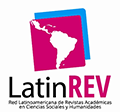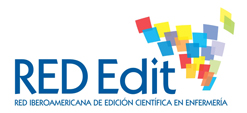PRIMER CONTACTO DE ESTUDIANTES DE ENFERMERÍA CON LA PERSONA ENFERMA: ANÁLISIS DE LA ETAPA DE VALORACIÓN.
DOI:
https://doi.org/10.22235/ech.v2i1.781Palabras clave:
Enfermería, Educación en Enfermería, Estudiantes de Enfermería.Resumen
En la primera instancia del proceso de enseñanzaaprendizaje se trata que el estudiante se introduzca en el conocimiento de la metodología científica y desarrolle habilidades intelectuales para identificar y resolver situaciones de cuidado, desde una base metodológica fundada en datos analizados, contrastados y organizados que permitan establecer una hipótesis de trabajo.
Objetivo: Identificar la articulación de los conocimientos teórico-prácticos, de estudiantes de Enfermería, en el primer contacto con personas enfermas.
Metodología: Mediante un estudio descriptivo se analizó la documentación de los Procesos Enfermeros focalizados en la etapa de valoración, realizada por
estudiantes en el segundo nivel de atención, durante agosto- noviembre 2012. Se realizó el análisis retrospectivo de 93 documentos, extrayendo variables y valorando la población por Patrones Funcionales. Se establecieron dos categorías: A comprendiendo valoración completa (motivo de ingreso, antecedentes, edad, sexo, índice de Norton y Barthel, patrones alterados, presencia de barandas y acompañante); B cuando faltó alguno de los elementos anteriores. Resultados: En un total de 93 valoraciones, 11 fueron incluidas en la categoría A, y 82 se incluyeron en la categoría B. Los aspectos donde se detectaron mayores dificultades fueron en la observación de la presencia de
barandas y acompañante, seguido por la aplicación de las escalas de Barthel y de Norton.Conclusiones: La dificultad de articular los conocimientos de forma integrada descuida aspectos importantes como la seguridad del paciente. Esto implicaría la revisión de metodologías de enseñanza-aprendizaje, centradas en el estudiante, donde el docente acompañe y tutele el proceso.
Descargas
Citas
Universidad Católica del Uruguay, visión y misión. Montevideo,
Facultad de Enfermería y Tecnologías de la Salud. Plan de Estudio de la la Licenciatura de Enfermería. Montevideo. 2006.
Universidad de Granada, Calidad, seguimiento y mejora del
Título,http://grados.ugr.es/enfermeria_ceuta/pages/calidad/compromisos,consultado 22 de febrero de 2014.
González Sara S.H., Moreno Pérez NE. Instrumentos para la enseñanza del proceso enfermero en la práctica clínica docente con enfoque de autocuidado utilizando Nanda-Nic-Noc. Enferm. glob. [revista en la Internet]. 201 ; 10(23): 89-95, 2011,Disponible en: http://scielo.isciii.es/scielo.php?script=sci_arttext&pid=S1695-61412011000300007&lng=es.
http://dx.doi.org/10.4321/S1695-61412011000300007.
Marriner-Tomey, Ann. El Proceso de Atención de Enfermería: un
enfoque científico. México: El Manual Moderno sa, 1983. 325 p. Disponible en: www.bibliotecas.unc.edu.ar/cgi-bin/Libreo
Gordon M. Diagnóstico enfermero: proceso y aplicación. Madrid.
Mosby/Doyma; 1996.
JARA CONCHA, Patricia; POLANCO ABELLO, Olga and ALVEAL
LAGOS, María. Percepción del rol profesional de alumnos de enfermeria de la Universidad de Concepción, Chile. Invest. educ. enferm [online]. 2005, vol.23, n.2 ,pp. 56-69 . Available from: <http://www.scielo.org.co/scielo.php.
Myrick F., Yonge O. Enhancing critical thinking in the preceptorship experience in nursing education. Journal of Advanced Nursing. 2004; 45(4):371–380.
BEATRIZ SAYAGO, Zoraida y CHACON, María Auxiliadora. Las
prácticas profesionales en la formación docente: hacia un nuevo diario de ruta. Educere [online]. 2006, vol.10, n.32 .Disponible en: ttp://www.scielo.org.ve/scielo.php. Visitado el 22 de Febrero de 2014.
Ozcan C. T., Oflaz F., SutcuCicek H. Empathy: the effects of
undergraduate nursing education in Turkey. International Nursing Review. 2010;57: 493–499.
Killam L. A. ,Luhanga F. , Bakker D. Characteristics of unsafe undergraduate nursing students in clinical practice: an integrative literature review. J NursEduc. [revista en internet] 2011 [acceso 02 de setiembre de 2013]; 50 (8):437- 46. Disponible en: 10.3928/01484834-20110517-05.
Jonsén E., Hanna-Leena M., Yvonne H. Finnish and Swedish
nursing students' experiences of their first clinical practice placement. Aqualitativestudy Nurse EducationToday [revista en internet] 2013 [acceso 22 de setiembre de 2013]; 33 (3): 297–302. Disponible en: http://dx.doi.org/10.1016/j.nedt.2012.06.012
Franklin, N. Clinical supervision in undergraduate nursing
students: A review of the literature. e-Journal of Business Education &Scholarship of Teaching [revista en internet] 2013 [acceso 18 de setiembre de 2013]; 7 (1):34-42.Disponible en: http://www.ejbest.org
Rué, J. La planificación y elaboración de actividades formativas
I: ámbito pedagógico y psicopedagógico. En:Rué, J. Qué enseñar y por qué: elaboración y desarrollo de proyectos de formación. Barcelona: Paidós Ibérica, [s.f.] cap. 4. 2002.
Langdon EJ, Wiik FB. Antropología, salud y enfermedad: una
introducción al concepto de cultura aplicado a las ciencias de la salud. Rev. Latino-Am. Enfermagem [Internet]. mai.-jun. 2010 [acceso en: 22 febrero de 2014];18(3):Disponible en: ttp://www.scielo.br/pdf/rlae/v18n3/es_23.pdf
Descargas
Publicado
Cómo citar
Número
Sección
Licencia
Derechos de autor 2015 Enfermería: Cuidados Humanizados

Esta obra está bajo una licencia internacional Creative Commons Atribución 4.0.

















